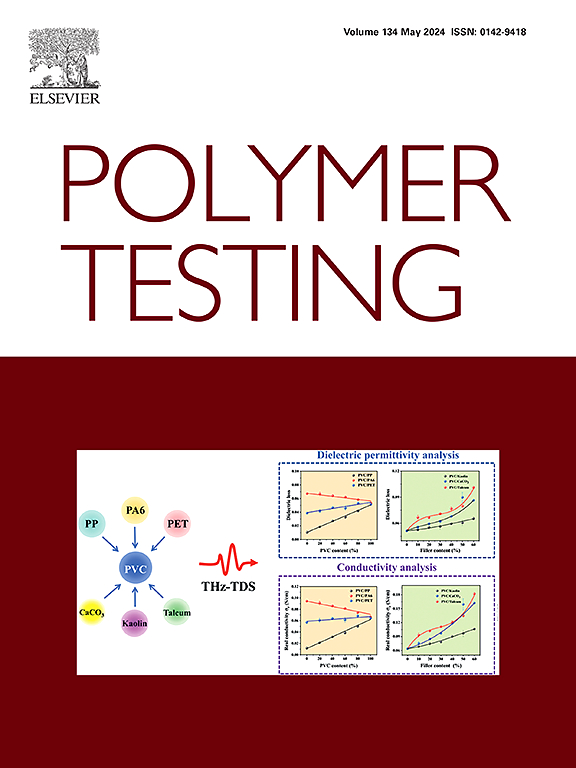通过非对称流场-流分馏(A4F)分析,在宏观和中观尺度上更清晰地了解不同天然橡胶基因型的动态结构
IF 5
2区 材料科学
Q1 MATERIALS SCIENCE, CHARACTERIZATION & TESTING
引用次数: 0
摘要
与合成弹性体不同,天然橡胶(NR)的结构会发生变化(动态结构化),在进入工业混炼机之前的储存过程中,其特性也会发生变化。在橡胶工业中,这被称为储存硬化。通过改变五氧化二磷上的结构化时间(t)(0 < t < 28 小时),对三种基因型(GT1、RRIM600 和 PB235)的 NR 样品进行了不同程度的结构化处理。然后通过测量华莱士塑性(P)的增加(宏观尺度)和使用非对称流场流动分馏(A4F)分析样品的中观结构(中观尺度)来确定样品的贮存硬化(ΔP)。通过监测ΔP 与结构化时间的函数关系,可以发现橡胶基因型所特有的各种行为。例如,基因型 GT1 和 PB235 的 NR 样品在 t < 12 小时内表现出不同的动力学,ΔP 随结构化时间的延长而增加,但最终达到相同的高点(t > 12 小时)。样品的 A4F 分析用于量化小于 1 μm 的微团聚体(microgel<1μ)。根据基因型的不同,微凝胶<1μ率随结构化时间的延长而不同程度地降低。ΔP与微凝胶<1μ速率之间存在非常明显的负相关关系,这表明硬化程度最高的 NR 样品所含的微凝胶<1μ速率最低,但大凝胶速率最高。本文章由计算机程序翻译,如有差异,请以英文原文为准。
A clearer understanding of the dynamic structuring of different natural rubber genotypes on a macroscopic and mesoscopic scale by asymmetrical-flow field-flow fractionation (A4F) analysis
Unlike synthetic elastomers, the structure of natural rubber (NR) evolves (dynamic structuring) and so do its properties during the storage before reaching an industrial mixer. In the rubber industry this is known as storage hardening. NR samples from three genotypes (GT1, RRIM600 and PB235) were subjected to different levels of structuring by varying the structuring time (t) on phosphorus pentoxide (0 < t < 28 h). Storage hardening (ΔP) of the samples was then determined by measuring the increase in Wallace plasticity (P) (macro-scale) and by analyzing their mesostructure (meso-scale) using asymmetrical flow field flow fractionation (A4F). Monitoring ΔP as a function of structuring time revealed a diversity of behaviors specific to the genotype from which the rubber originated. For example, NR samples from genotypes GT1 and PB235 exhibited different kinetics for t < 12 h, an increase in ΔP with structuring time, but reached the same final plateau (t > 12 h). An A4F analysis of the samples was used to quantify the fraction of microaggregates smaller than 1 μm (microgel<1μ). The microgel<1μ rate decreased with structuring time to varying extents depending on the genotype. A very significant negative relationship was found between ΔP and the microgel<1μ rate, indicating that the NR samples that hardened the most contained the lowest microgel<1μ rate, but the highest macrogel rate.
求助全文
通过发布文献求助,成功后即可免费获取论文全文。
去求助
来源期刊

Polymer Testing
工程技术-材料科学:表征与测试
CiteScore
10.70
自引率
5.90%
发文量
328
审稿时长
44 days
期刊介绍:
Polymer Testing focuses on the testing, analysis and characterization of polymer materials, including both synthetic and natural or biobased polymers. Novel testing methods and the testing of novel polymeric materials in bulk, solution and dispersion is covered. In addition, we welcome the submission of the testing of polymeric materials for a wide range of applications and industrial products as well as nanoscale characterization.
The scope includes but is not limited to the following main topics:
Novel testing methods and Chemical analysis
• mechanical, thermal, electrical, chemical, imaging, spectroscopy, scattering and rheology
Physical properties and behaviour of novel polymer systems
• nanoscale properties, morphology, transport properties
Degradation and recycling of polymeric materials when combined with novel testing or characterization methods
• degradation, biodegradation, ageing and fire retardancy
Modelling and Simulation work will be only considered when it is linked to new or previously published experimental results.
 求助内容:
求助内容: 应助结果提醒方式:
应助结果提醒方式:


